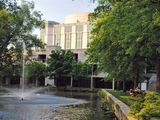The Water Research Foundation (WRF) releases the CLASIC tool
For stormwater and green infrastructure costs and benefits
Today, The Water Research Foundation (WRF) released the CLASIC tool, which utilizes a life cycle cost framework to support feasibility and planning of stormwater infrastructure. CLASIC helps stormwater professionals, community planners, and local decision-makers understand and weigh the estimated costs, reductions in runoff and pollutant loads, and co-benefits of various planning scenarios as they consider stormwater management projects. Register for an EPA webinar, scheduled for May 26, that will demonstrate the free CLASIC tool and provide answers to frequently asked questions.
The CLASIC tool is fully interfaced with GIS and links with national databases that can be applied at a community level. Users have the option to automatically upload data from national databases (e.g., census, national land cover database, PRISM climate database, digital elevation models, etc.) or to upload their own data sets. The tool allows users to build and compare multiple stormwater infrastructure options and enables simulation of various climate scenarios. Users can select from a variety of green and/or gray stormwater practices, like rain gardens, infiltration trenches, permeable pavement, green roofs, storage vaults, wet ponds, and stormwater harvesting.
The CLASIC tool allows users to prioritize specific social, environmental, and economic co-benefits, such as building energy efficiency, mental health impacts, or groundwater flow increase. Users can also set targets for variables like pollutant reduction, runoff reduction, or cost. The CLASIC outputs are displayed in an immersive set of charts, graphs, and tables that can be analyzed, printed, and shared.
The creation of this tool was funded by the U.S. Environmental Protection Agency's (EPA) Office of Research and Development (ORD) through the grant opportunity “National Priorities: Life Cycle Costs of Water Infrastructure Alternatives” (EPA Grant Number: R836173). Additional information about the project is available through the EPA.
Posted: April 27, 2021, 8:09 AM
